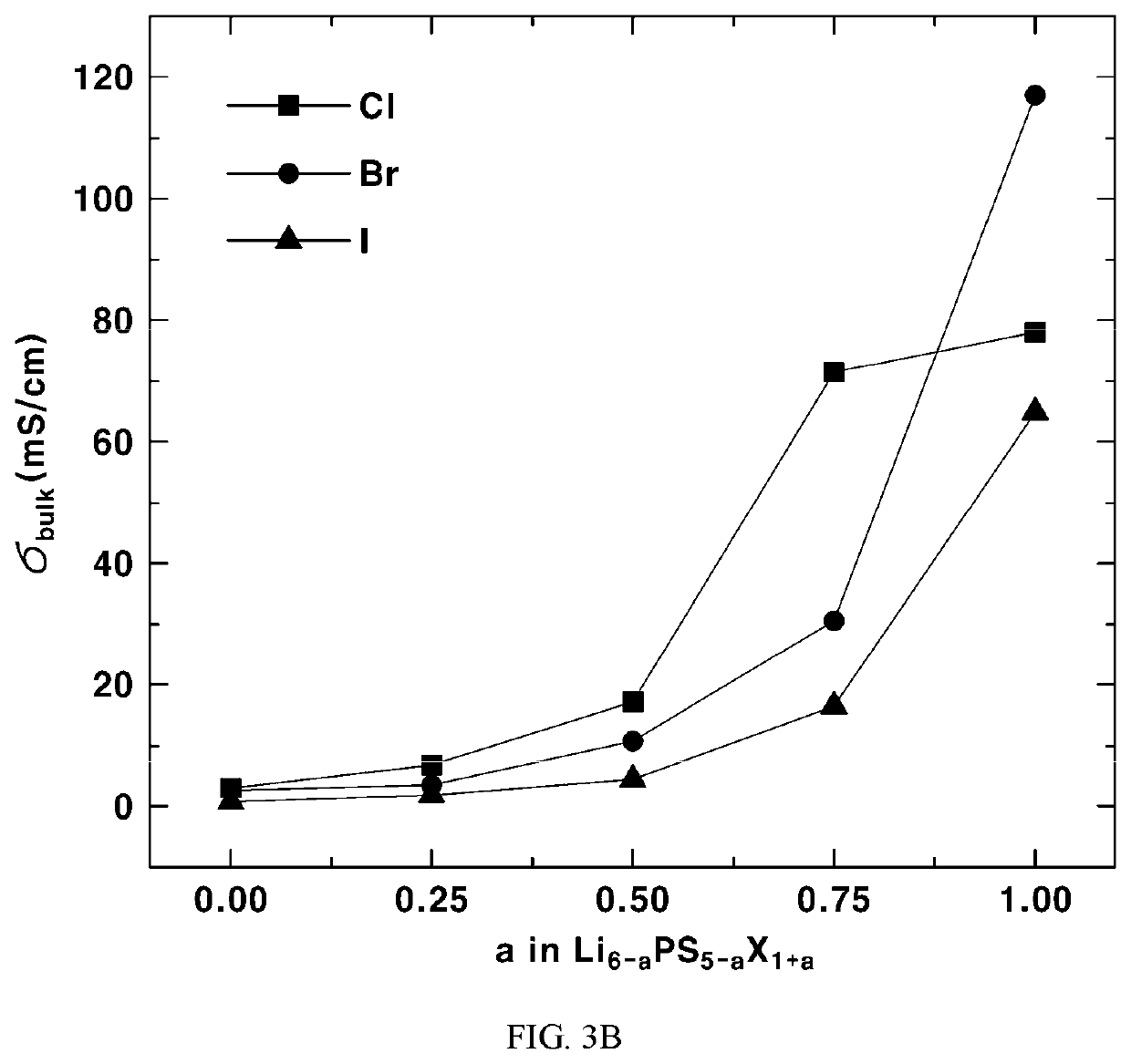Solid electrolyte with excellent ion conductivity
a solid electrolyte and excellent technology, applied in the direction of electrolytes, non-metal conductors, cell components, etc., can solve the problems of constant raising of electrical leakage and fire hazards, and achieve excellent ionic conductivity
- Summary
- Abstract
- Description
- Claims
- Application Information
AI Technical Summary
Benefits of technology
Problems solved by technology
Method used
Image
Examples
experimental example 1
sition Having Excellent Ionic Conductivity by Setting Size of Monoatomic Disorder Area and its Standard Deviation (STD) of Compounds, Li6[B][C]5D, Li7[B][C]6 and Li5[B][C]4D2 Depending on Range of a for Formulas 3, 4 and 5 Represented by Formula 2, (Li6-a[BC4]C1−aD1+a)
[0097]In Li6-a[BC4]C1−aD1+a, among the compounds represented by Formula 2, wherein D is Cl, Br, or I, and the range of a is −16), area size, STD, and ionic conductivity of each compound were calculated, and the results are shown in Table 1 below.
TABLE 1Monoatomic anion disorderLi area size (anion area size)D−S2−D−S2−D−S2−D−S2−Li6−aPS5−aD1+a# of atomsIn 4aIn 4aIn 4cIn 4c4a4a4c4cIonic conductivityDaDSareaareaareaareaSTDareaareaareaarea(mS / cm) σ [σmin, σmax]−108 0%100% 0%100%0.0072.632.61168.6Cl044100% 0% 0%100%0.23912.902.42 0.02 [0.004, 0.07] 75% 25% 25% 75%0.10342.772.692.612.49 45 [35, 58] 50% 50% 50% 50%0.06382.662.652.592.50 115 [92, 142] 50% 50% 50% 50%0.09312.752.552.572.51 183 [128, 260] 25% 75% 75% 25%0.0826...
experimental example 2
nductivity Through Calculation of Area STD of Li6[B][C]5D and Li7[A][C]5D, Compounds Represented by Formulas 3 and 7
[0099]For Li6[B][C]5D and Li7[A][C]5, among the compounds represented by Formula 3 and Formula 7, the ionic conductivity was evaluated based on area size STD, and the results are shown in Table 2 below and in FIG. 4 and FIG. 5.
TABLE 2SystemArea size STDRankσbulkB—C—D P—Te—Br0.0838161.06in Li6[B][C]5D Sb—Te—Br0.0871224.14(Formula 3)As—Te—Br0.0927332.29As—Se—Cl0.0950417.90Sb—Te—I0.1070520.72N—Te—I0.1087613.47Sb—Se—Cl0.1168710.46P—Se—Cl0.1177831.13N—Te—Br0.1189922.18As—Te—I0.11961035.58P—Te—I0.12151125.04P—Se—Br0.14071217.28P—Te—Cl0.14231354.55Sb—Se—Br0.15121410.91A—C—D P—S—Cl0.15961518.8in Li7[A][C]5DSi—Se—Cl0.0522129.6(Formula 7) Ge—Se—Cl0.0569217.5Ge—Te—I0.0572314.6Sn—S—Cl0.058547.6Si—Te—I0.0588549.9Ge—Te—Br0.0684647.0Ge—Se—Br0.0714799.8Sn—Te—I0.0722820.9Si—Te—Br0.0744974.0Si—S—Cl0.08311040.7
[0100]As can be seen from Table 2, and FIG. 4 and FIG. 5, when C is oxygen (O)...
experimental example 3
nductivity Through Calculation of Area STD of Halogen-Free Li7[B][C]6 and Li8[A][C]6, Compounds Represented by Formulas 4 and 8
[0102]For Li7[B][C]6 and Li[A][C]6, not containing halogen, which are compounds represented by Formula 4 and Formula 8, the ionic conductivity was evaluated based on the STD of the area size, and the results are shown in Table 3 below and in FIG. 6 and FIG. 7.
TABLE 3SystemArea size STDRankσbulkB—CP—Se0.011719.1Li7[B][C]6P—S0.01742168.6(Formula 4)Sb—S0.02243360.8Sb—Se0.0340431.9A—CSi—Te0.01091185.0in Li8[A][C]6Si—Se0.01462188.9(Formula 8)Sn—Te0.03203176.1Ge—Se0.03684234.4Si—S0.0374566.7Ge—S0.0463666.4
[0103]As may be seen from Table 3 and in FIG. 6 and FIG. 7, in the case of a composition containing no halogen, the one type of anion is located in the monoatomic anion, so the area size is similar and thus the STD is very low, and as a result, a low σbulk is obtained.
PUM
| Property | Measurement | Unit |
|---|---|---|
| size | aaaaa | aaaaa |
| ionic conductivity | aaaaa | aaaaa |
| disorder | aaaaa | aaaaa |
Abstract
Description
Claims
Application Information
 Login to View More
Login to View More - R&D
- Intellectual Property
- Life Sciences
- Materials
- Tech Scout
- Unparalleled Data Quality
- Higher Quality Content
- 60% Fewer Hallucinations
Browse by: Latest US Patents, China's latest patents, Technical Efficacy Thesaurus, Application Domain, Technology Topic, Popular Technical Reports.
© 2025 PatSnap. All rights reserved.Legal|Privacy policy|Modern Slavery Act Transparency Statement|Sitemap|About US| Contact US: help@patsnap.com



